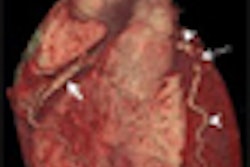Virtual colonoscopy may have been dealt a setback this week after members of a U.S. government panel expressed doubts about the technology. Panel members charged with recommending whether VC should receive Medicare reimbursement said there was incomplete evidence of VC's cost-effectiveness and overall benefit as a screening tool for colorectal cancer.
Wednesday's meeting in Baltimore of the Medicare Evidence Development and Coverage Advisory Committee (MedCAC) was part of the process set up by the U.S. Centers for Medicare and Medicaid Services (CMS) to determine whether the federal government should pay for VC, or CT colonography (CTC), screening. The panel consists of representatives from both radiology and gastroenterology, who listened to evidence presented on VC's clinical and economic effectiveness and later cast votes on the readiness and suitability of VC for Medicare coverage.
On the positive side, the meeting brought together radiologists and some gastroenterologists who had traditionally been divided over VC's viability as an alternative to optical colonoscopy. MedCAC panelists found much to recommend about the noninvasive exam in terms of sensitivity, robustness, and overall safety profile.
But key players whose support may be crucial for the eventual adoption of VC as a covered exam under Medicare balked at what they called incomplete evidence of VC's effectiveness on several fronts.
Unproven benefits?
Some MedCAC panel members said that the benefits of finding and working up the extracolonic findings from virtual colonoscopy remain unproven, and that the associated costs and risks are poorly understood. Others stated that based on available evidence, screening with VC would not necessarily result in a cost savings, at least at current screening compliance rates that have hovered for years at less than 50% of eligible adults ages 50 and older.
In March of this year, the American Cancer Society, the U.S. Multisociety Task Force on Colorectal Cancer, and the Reston, VA-based American College of Radiology (ACR) issued new cancer screening guidelines that included a recommendation that VC be considered an acceptable option for screening. However, a national coverage decision will be needed before CMS can begin to pay for the exam as a covered test under Medicare.
Toward that end, CMS asked for public comment on the proposal, set up the MedCAC panel, and arranged for its members to vote on CTC's appropriateness as a screening method at the end of yesterday's meeting.
Members of that panel voted their recommendations following the day's discussion of VC by members representing government, industry, consumers, and both sides of the traditional divide between radiology and gastroenterology.
Organizations represented by MedCAC included the ACR, the Bethesda, MD-based American Gastroenterological Association (AGA), the Oak Brook, IL-based American Society for Gastrointestinal Endoscopy (ASGE), and the Bethesda, MD-based American College of Gastroenterology (ACG). The meeting was also open to the public.
At the close of the meeting, AuntMinnie.com spoke by telephone with Dr. Joel Fletcher, an associate professor of radiology at the Mayo Clinic of Rochester, MN, and a member of the ACR's colon cancer screening committee, who discussed highlights of the meeting for this story.
Dr. Mary Barton, scientific director of the U.S. Preventive Services Task Force (USPSTF), reported that the high overall per-patient sensitivity did not differ between optical colonoscopy and VC for the detection of large lesions (≥ 10 mm), nor in most cases for smaller lesions ranging from 6 to 9 mm in diameter, according to Fletcher.
"There was not a lot of discussion about that point, and most [panel members] accepted it," Fletcher said. There were comments to the effect that VC's sensitivity may be slightly lower than optical colonoscopy for 6- to 9-mm lesions, he added, but "current evidence supports the fact that we do as well as endoscopy for the large adenomas and we do pretty well for [6- to 9-mm lesions]."
Barton also said that in terms of direct risk of harm to the patient (particularly the risk of colonic perforation), VC was probably superior to optical colonoscopy. Stating that optical colonoscopy is an imperfect exam that can produce such rare complications, Barton said that in contrast, complications almost never occur in screening virtual colonoscopy.
In terms of performance characteristics, Barton said the National CT Colonography Trial (New England Journal of Medicine, September 18, 2008, Vol. 359:12, pp. 1208-1217) and the Department of Defense trial (NEJM, December 4, 2003, Vol. 349:23, pp. 2191-2200) were evidence that VC could deliver favorable results in a variety of settings.
In his presentation, USPSTF chair Dr. Ned Calonge, an associate professor of family medicine, preventive medicine, and biometrics at the University of Colorado Health Sciences Center in Denver, said that the USPSTF could give VC only an "I" for incomplete evidence, according to Fletcher.
Calonge said this conclusion was based on the unknown impact of extracolonic findings, and the unknown cumulative impact of radiation delivered in the course of periodic VC screening exams beginning at age 50.
Dr. C. Daniel Johnson, a professor of medicine at the Mayo Clinic in Scottsdale and Phoenix, AZ, discussed the issue of radiation dose, and "I think [Johnson's comments on radiation dose] made the panel more comfortable with CTC but did not eliminate those concerns," Fletcher told AuntMinnie.com. CTC exams generally deliver radiation doses not exceeding 2 mSv.
Statistical models
Ann Zauber, Ph.D., an associate attending biostatistician at Memorial Sloan-Kettering Cancer Center in New York City, discussed the findings of a technology assessment by the U.S. Department of Health and Human Services' Agency for Healthcare Research and Quality, as expressed in three different cancer simulation models known as MISCAN-COLON, SimCRC, and CRS-SPIN.
All of the models generally found that VC yields gains in life years, Fletcher said. According to the SimCRC model specifically, "if you screen 1,000 patients [with optical colonoscopy] you gain 151.6 life years," he said of Zauber's remarks. "If you screen the same patients with CTC you will have 143 or 150 life years gained depending on the ACRIN [National CT Colonography Trial] results or Pickhardt [et al, NEJM, 2004] results."
The other models looked at the overall costs of screening from age 65 to the end of life and found that CTC was not cost-effective assuming a price per exam of $488, which was assumed to be the Medicare reimbursement level.
"[CTC] wasn't competitive from an economic standpoint compared to colonoscopy. [But] it does result in a large number of life years gained, and does so at not a lot of cost, and some panel members raised that point," Fletcher said.
Yet Zauber also noted that if compliance were to increase from 50% to 62.5% as a result of implementing CTC screening, the noninvasive exam would become cost-effective at that point. Studies suggest that greater numbers of individuals might be screened if they could do so noninvasively.
Dr. Darren Schwartz from the University of Wisconsin Medical School in Madison said that while screening endoscopy volumes have remained stable at his tertiary care center, about 70% more patients have been screened for colorectal cancer following implementation of a VC screening program.
Echoing Schwarz's remarks, Dr. Brooks Cash, chief of gastroenterology at the National Naval Medical Center in Bethesda, MD, said that colorectal cancer screening at his institution has increased by 70% since VC was added as a screening option.
A representative from Colon Health Centers of America in Newark, DE, reported that 40% of her firm's patients said they would have opted for no colorectal cancer screening if virtual colonoscopy were not available.
Still, the panel generally considered the available reports to represent "a low level of evidence," Fletcher said.
With respect to extracolonic findings, the panel generally agreed that 5% to 8% of the screening population demonstrate potentially significant findings at VC, while the National CT Colonography Trial (ACRIN 6664) was an "outlier" with its much higher reported rate of 16%, Fletcher said. Published data from several studies show only a moderate average cost of $25 to $34 per patient to work up these findings.
However, panel members from USPSTF and other organizations expressed dissatisfaction with the quality of available research. With regard to the workup of such findings, "no one has proven that they do not result in harm," said one panel member, according to Fletcher.
Dr. Elizabeth McFarland, chair of the ACR's colon cancer committee and a radiologist at St. Luke's Hospital in Chesterfield, MO, addressed extracolonic findings, radiation dose, and other issues raised in the course of the meeting, Fletcher said.
At the end of the day panelists were asked to vote on several specific questions on a scale of 1 (no confidence) to 5 (high confidence) with regard to VC's sensitivity, suitability for screening, and ability to deliver a "net health benefit for Medicare beneficiaries."
CMS will tabulate the results of the MedCAC votes, analyze the available evidence and comments, and announce its decision in February 2009.
"It's important to note that the AGA was ... firmly in collaboration with the ACR, saying this could help a certain number of patients," Fletcher said. "It's the ACG and the ASGE that lined up on the other side ... I don't think it looks good."
By Eric Barnes
AuntMinnie.com staff writer
November 20, 2008
Related Reading
Gastroenterologists embrace VC screening, with caveats, October 28, 2008
CMS announces VC evidence meeting, September 26, 2008
ACR, others exhort CMS to cover virtual colonoscopy, June 19, 2008
CMS launches comment period for VC coverage, May 20, 2008
American Cancer Society recognizes virtual colonoscopy screening benefit, March 5, 2008
Copyright © 2008 AuntMinnie.com



















